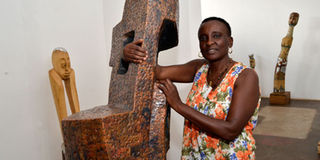Nabulime keeping HIV topic alive with bits of wood

Dr Nabulime shows one of her sculptures. PHOTO BY ABUBAKER LUBOWA
What you need to know:
- Even when she was stranded with the choice for her master’s degree project, it was the dean that pointed her to her roots in sculpture.
- Nabulime’s works, mostly made up of bold experimentation with wood, clay and other materials, have been exhibited across the globe in galleries and office spaces.
- Dr Nabulime’s exhibition held at the Makerere University Margaret Trowell gallery in September last year.
Sculpture was not always Dr Lilian Nabulime’s choice. In fact, for her Bachelors’ Degree in Industrial and Fine Art at Makerere University, she simply offered it alongside painting.
“I initially wanted to major in painting but Francis Musango Gwa Ntamu, the Dean of the School of Art at the time, encouraged me to choose sculpture,” Dr Nabulime says.
Even when she was stranded with the choice for her master’s degree project, it was the dean that pointed her to her roots in sculpture.
For more than 20 years, the 53-year-old senior lecturer at Makerere University, has exploited her talent as a sculptor, carving wood into distorted human figures and abstract creations and while at it, tackling issues that range from politics, religion, race, life and HIV, among others.
Nabulime’s works, mostly made up of bold experimentation with wood, clay and other materials, have been exhibited across the globe in galleries and office spaces.
The first thing that comes to mind when you look at monumental art works is the time invested to get the pieces to that stage.
Most of the time, sculptors have to use waste metal, rocks and unwanted logs.
For Dr Nabulime, making works out of these abandoned or discarded living things is like making a deal with death to create new life.
If there is anything outstanding about her work, it is the attention to detail, improvisation and her remarkable ability to appropriate abandoned nature. Dr Nabulime did a number of sculptures using tree roots, of which Kavuyo (1990) and Ancestors (1993) stand out.
With roots, she played around with the shapes dictated by the plants while adding head-like carvings to create an impression that the roots were growing into warring reptiles.
Kavuyo, according to Dr Nabulime, was done at the time Uganda was experiencing political turmoil and thus the work’s intense nature.
With time, she has worked with more than just roots, for instance, works that followed her masters were monumental and mostly made out of stems, static and lifeless yet she later tried other forms that saw her give work synthetics that created life, colour and movement.
Mostly done on flat wood, they are carvings of girls in different shapes combined with metallic waste such as beverage cans that she uses to create body features such as breasts while at the same time expressing the colourful life of these women.
Motivation
“That was during my Phd at Newcastle University; I was challenged to make sculptures out of flat wood as opposed to using a stem or root,” she says.
Works such as Courage, Empowered, Confident, Dreams and Consequences were centrepieces for
Dr Nabulime’s exhibition held at the Makerere University Margaret Trowell gallery in September last year. With a marriage of wood and coloured aluminium, the exhibition went skin deep into topics surrounding HIV, her female students’ lifestyles as well as pushing a message of courage to a modern woman.
She notes that her emphasis on messages targeting women is the fact that we live in a world where things are happening so fast. “Young women should be empowered to be courageous and confident,” she says.
The soft-spoken lecturer is passionate about HIV in modern Africa. “Because it is 2018 and just when you thought HIV would be no more.... It is still here with us,” she says.
Dr Nabulime completed her doctorate degree last year and HIV dominated much of her thesis. With many of her sculptures about the scourge being abstract of genitalia, she noticed few Ugandans are willing to talk about them.
Today, Dr Nabulime uses art as a social vehicle to drive the message home. For many, her message is around protecting themselves while for the sick, she offers hope that there is life beyond the disease.
Tomorrow, read about Teopista Twembi whose past experience with discrimination inspired her to fight injustice.




